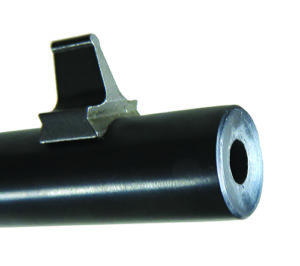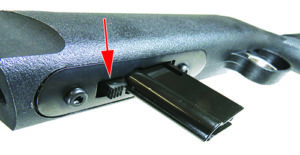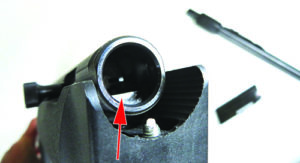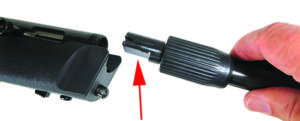GUN TESTS GRADE: A (BEST BUY)
$212
The Model 64 Takedown has a minimalist approach. This rifle is basically a Model 64 barrel and action attached to an abbreviated polymer stock. It breaks down into two components: a receiver assembly and a barrel assembly.
| Action | Semi-auto, blowback |
| Overall Length | 36.25 in. |
| Disassembled Length | 20.2 in. |
| Overall Height (w/o optic) | 8.0 in. |
| Weight Unloaded | 4.5 lbs. |
| Weight Loaded | 4.6 lbs. |
| Barrel Length | 16.5 in. |
| Barrel | Blued steel |
| Receiver | Blued steel |
| Buttstock | Textured black synthetic; serrated buttpad, sling studs |
| Buttstock Length of Pull | 13.5 in. |
| Magazine | (1) 10-round detachable rotary |
| Front Sight | Steel post |
| Rear Sight | Adjustable notch rear |
| Trigger Pull Weight | 5.4 lbs. |
| Safety | Manual hammer block |
| Warranty | 1-year limited |
| Telephone | (800) 370-0708 |
| Website | SavageArms.com |
| Made In | Canada |
The Model 64 action is a simple blowback style. The receiver is drilled and tapped to mount a base, and there were no screw plugs in the tapped holes, so you can see into the action. Debris could easily get into the action if the rifle is dropped in mud, sand, or water. The serrated bolt handle was a roller-style, meaning it rolled as it is retracted to cock and load the chamber. You can push the handle in to lock the bolt back. The bolt does not lock back after the last shot fired. The safety lever was located on the right-hand side of the receiver above the trigger and directly behind the bolt lever. A hole indicates the safety is in the forward position and the rifle is ready to fire. You can see the bolt through the hole into the action. An “S” is stamped into the steel indicating the safety lever is in the Safe position.

The trigger was smooth and narrow. Unlike on the KelTec and Ruger, we needed to break our shooting grip to manipulate the safety. The bottom metal with the magazine well is screwed into the stock, and a ridged metal magazine release is forward of the well. You need to press it forward to remove the magazine. To insert the mag, you use the front edge of the magazine to push the magazine-release lever forward and then insert the magazine. It was a bit tricky at first, but soon became rote.
We busted our thumbs on the steel magazine. We found the easiest way to load was to press down and to the rear of the cartridge while inserting it. The steel-body magazine held 10 rounds, and the tenth was hard to load.

The stock is the full-size Model 64 stock cut off just forward of the receiver. Sling studs were installed, and we like the ease of installing a sling. The polymer stock had a textured finish and molded checkering at the pistol grip. We liked the texture of the stock. Though there was no forend to grasp, we found we could grasp the front edge on the stock and pull it into our shoulders.
The round barrel sported a dovetailed front blade and an adjustable rear sight. A ladder adjusted elevation, and a hammer would be needed to tap it for windage correction. These sights were basic.

The barrel has simple threading, and a serrated nut is held in place with a spring-loaded detent to keep the barrel and receiver together. To attach the barrel, just crank it on hand-tight, and you are ready to go hot. This procedure was not as fast as the Ruger’s, but it was super simple. The bottom section of the barrel assembly is milled flat so it fits in the receiver the same way every time. The muzzle was nicely crowned. Like the Ruger, the Savage was super easy to clean with the rifle broken down.

Going hot, we were surprised at the accuracy of the Model 64. In some instances we were able to shoot one ragged hole, and this is with iron sights. With a red dot mounted, we were even more surgical. Our best five-shot group measured 0.37 inches with the CCI Blazer 38-grain LRN ammo. The Remington Thunderbolt 40-grain LRN was close behind with a 0.43-inch group. Suffice it to say, the Savage averaged 0.5- to 0.7-inch groups with all the bargain ammo. We were smitten. After extended shooting, the barrel did become hot, so you need to take care. The trigger-pull weight averaged 5.4 pounds — the best out of the three rifles tested. It had a lot of take up but broke very consistently.
We purchased a set of Weaver #12 bases ($10) to mount the Crimson Trace red dot and continued to shoot one ragged hole in the target per magazine if we concentrated.
Our Team Said: The Model 64 Takedown had excellent accuracy. It was in between weight and breakdown length compared to the KelTec and Ruger. The deciding factor was the price. At $150 dollars less, it is very affordable and offered the best accuracy, but with no frills.
22 LR Range Data
| Winchester Xpert HV 36-grain HP | KelTec SU22CA | Ruger 10/22 Takedown | Savage 64 Takedown |
| Average Velocity | 1236 fps | 1250 fps | 1277 fps |
| Muzzle Energy | 122 ft.-lbs. | 125 ft.-lbs. | 130 ft.-lbs. |
| Smallest Group | 1.06 in. | 0.74 in. | 0.74 in. |
| Average Group | 1.09 in. | 0.82 in. | 0.76 in. |
| Federal Auto Match 40-grain LRN | KelTec SU22CA | Ruger 10/22 Takedown | Savage 64 Takedown |
| Average Velocity | 1133 fps | 1143 fps | 1103 fps |
| Muzzle Energy | 114 ft.-lbs. | 116 ft.-lbs. | 108 ft.-lbs. |
| Smallest Group | 1.26 in. | 0.68 in. | 0.69 in. |
| Average Group | 1.38 in. | 0.71 in. | 0.73 in. |
| CCI Blazer 38-grain LRN | KelTec SU22CA | Ruger 10/22 Takedown | Savage 64 Takedown |
| Average Velocity | 1218 fps | 1229 fps | 1224 fps |
| Muzzle Energy | 125 ft.-lbs. | 127 ft.-lbs. | 126 ft.-lbs. |
| Smallest Group | 1.34 in. | 1.12 in. | 0.37 in. |
| Average Group | 1.40 in. | 1.22 in. | 0.39 in. |
| Remington Thunderbolt 40-grain LRN | KelTec SU22CA | Ruger 10/22 Takedown | Savage 64 Takedown |
| Average Velocity | 1163 fps | 1197 fps | 1183 fps |
| Muzzle Energy | 120 ft.-lbs. | 127 ft.-lbs. | 124 ft.-lbs. |
| Smallest Group | 1.48 in. | 0.76 in. | 0.43 in. |
| Average Group | 1.50 in. | 0.81 in. | 0.50 in. |




























is the barrel threaded? for attachments?
Savage Model 64 Takedown 40207 22 LR
I really enjoyed this article mainly because of it’s positive review as compared to what I read elsewhere and want to thank you. The Savage 64 is a Cooey Machine & Arms Co. design, the Model 64 that was first manufactured by Winchester with a plastic magazine which was replaced on the Model 64B with the current Zinc Alloy version that we see. 1964 is also the same year that Ruger came out with their famous Model 10/22 with the ingenious rotary 10 round magazine. I have to say that the 10 rounds stick mags have never appealed to me, they always seem to be in the wrong spot when handling the rifle. Winchester Western shut down their operations in Canada in 1979 and the Model 64 design was purchased by Lakefield Arms which improved the model by adding the left side lever safety to replace the push button bolt handle lock. Lakefield Arms was purchased by Savage Arms in 1995 including all of their 22 models. The bolt action designs became the Model 1G, IIG, 93 in 22WMR and they expanded the line which now includes Left Hand models in the 64 line as well as the 64 Take Down. The older Cooey model 64B had the same problem with the magazine safety catch, there is an after-market replacement part that solves this issue, If you are a little handy, you can drill a hole in the forward part of the magazine release lever and insert an appropriate size screw that will protrude and give a much better purchase to operate the magazine release. Due to the short fore end of the take-down design I find the magazine is really in the way when holding the rifle and this is my biggest gripe (it did not stop me from buying one as the “cool” factor is there) However, a couple of months before one was available to purchase in my area, I found on an online auction site, two 5 round mags that are a perfect fit for the model 64. They are original mags and not modified as these are cast metal and have what seem to be the same finish and the same markings as the 10 round mags and were made in Canada. So far, I haven’t been able to find any additional information on them and I am not aware of any bolt or semi-auto action that would have used them. I am thinking that they may have been a prototype development addressing my (and others) gripe on the long mags but couldn’t be marketed due to the competition from Ruger ( who would want a 5 round mag on a semi-auto – longer mags are usually more tedious to reload) The 5 round sure make for a slimmer design and are un-obstructive on the 64 take-down design. And yes, they are perfectly appropriate for hunting small game. When you think that Browning came out around that time period with the A-Bolt 22 and a 5 round mag and the next option was the 15 round, as they totally skipped the 10 round, go figure. If anyone has information on these 5 round mags, I would like to hear from you.
Hi Folks, I was amazed at your test results. I had really good groups at 25 yards with many standard issue 22LR brands, but not as good as you report. It is a nice simple rifle and I agree that the magazine release is a bit tricky.
My only issue with the more recently manufactured rifles is the factory iron sights. Over the last two years (2021-2023), Savage has sent me three brand-new model 64 takedown rifles and each one identically shot 4 inches high at 25 yards using the as-built, factory iron sights. The factory front sight was simply not tall enough even with the rear buckhorn sight sitting on the barrel (no insert). The last time I sent it back for service, Savage replaced the front sight with a taller iron sight, but it fell out of the dovetail during shipping. So I purchased a .5″ HiViz front sight and replaced it myself which solved the issue. I also recently purchased an EGW scope mount and mounted a red dot 1x scope.
From what I’ve experienced, plan on spending the money for sight mounts if you want to use this firearm.
Sam do you have the part number of the 5″ HiViz sight?
For Xmas I bought myself a present, a brand new Savage 64 in 22LR. I loved the looks of the gun and the feel. I was excited to take it out and start plinking before I put it to use on the trapline. Almost immediately the gun couldn’t cycle through a full magazine without jamming. I’ve been around guns for 62 years and know that some guns are finicky, so I proceeded to test fire 8 different varieties of ammo. Not one would cycle cleanly. This was a huge disappointment. I inspected it thoroughly and found no visible issues. My next step was to contact Savage Arms costumer service. After several failed attempts I decided to send an email, again, no response. Several days later l decided to try a different approach and asked for sales. Of course someone answered the phone! I told them I had been trying to contact customer service, but no one would answer. The sales rep said they were very busy. I asked if a manager was available and was told no. The sales rep said there was nothing she could do, and recommended I keep trying the customer service number. After several more attempts I finally got through to a representative who suggested I return the gun for repair, which would take approximately 14 days. I sent it back and began the wait. After 15 days I called again, not expecting it to be ready, but curious as to how much longer it would take. The lady said they just received my gun the day before. This made me very unhappy. I had tracked the shipment and discovered they receive the package two days after I shipped it, so it sat in their receiving department for 13 days before it was forwarded to their repair department. A week later my wife called for status and was told they had no idea when the gun would be shipped back to me. After asking several questions, my wife discovered Savage was experiencing problems with a part on the tail end of the receiver. The part was reengineered and was currently in production. My wife told her it sounded like they should have issued a recall, then she requested to speak to a manager. She was transferred to a sr. customer service rep who told her the same thing. My wife was desperately trying to get some sort of delivery date. She asked if he could give her an estimate as to when it might ship . . . two weeks, six months, nine months, a year? His response, “It shouldn’t take nine months.” Wow! She went on to express her disappointment and frustration. The rep offered her a replacement gun that had the original part on the tail end of the receiver. This was confusing because he said Savage is reverting back to their original part yet there was talk about reengineering the piece. Anyway, my wife accepted his offer thinking this will be a quick fix to our problem. When she asked how soon the replacement gun would ship he said they don’t have any in stock and could not quote a delivery date. WTH? This is extremely disappointing! Savage brags about their quality and customer service, but my experience with the quality of the product and with their service has been horrible. This is the first Savage product I have ever purchased and will most definitely be the last.